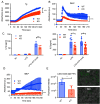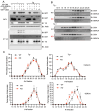Cisd2 deficiency impairs neutrophil function by regulating calcium homeostasis via Calnexin and SERCA
- PMID: 38627949
- PMCID: PMC11139677
- DOI: 10.5483/BMBRep.2024-0011
Cisd2 deficiency impairs neutrophil function by regulating calcium homeostasis via Calnexin and SERCA
Abstract
In the context of aging, the susceptibility to infectious diseases increases, leading to heightened morbidity and mortality. This phenomenon, termed immunosenescence, is characterized by dysregulation in the aging immune system, including abnormal alterations in lymphocyte composition, elevated basal inflammation, and the accumulation of senescent T cells. Such changes contribute to increased autoimmune diseases, enhanced infection severity, and reduced responsiveness to vaccines. Utilizing aging animal models becomes imperative for a comprehensive understanding of immunosenescence, given the complexity of aging as a physiological process in living organisms. Our investigation focuses on Cisd2, a causative gene for Wolfram syndrome, to elucidate on immunosenescence. Cisd2 knockout (KO) mice, serving as a model for premature aging, exhibit a shortened lifespan with early onset of aging-related features, such as decreased bone density, hair loss, depigmentation, and optic nerve degeneration. Intriguingly, we found that the Cisd2 KO mice present a higher number of neutrophils in the blood; however, isolated neutrophils from these mice display functional defects. Through mass spectrometry analysis, we identified an interaction between Cisd2 and Calnexin, a protein known for its role in protein quality control. Beyond this function, Calnexin also regulates calcium homeostasis through interaction with sarcoendoplasmic reticulum calcium transport ATPase (SERCA). Our study proposes that Cisd2 modulates calcium homeostasis via its interaction with Calnexin and SERCA, consequently influencing neutrophil functions. [BMB Reports 2024; 57(5): 256-261].
Conflict of interest statement
The authors have no conflicting interests.
Figures




References
Publication types
MeSH terms
Substances
LinkOut - more resources
Full Text Sources
Molecular Biology Databases
Research Materials

